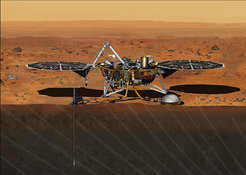Inversion of single-station seismic data for shallow and crustal structure of Mars for the InSight mission
The InSight mission to Mars is scheduled for launch in May 2018 and will deliver a very broad-band seismic sensor (SEIS) to the surface of the planet by November 2018. MPS is contributing to the SEIS project by developing, building, and testing the leveling system for the seismometer.
In the absence of actual ground truth data, current estimates of seismic activity on Mars are based on fault mapping, surface dating, and assumptions about the annual seismic moment release. In the resulting range of possible scenarios, observable seismicity is likely considerably less abundant than on Earth, so as much information as possible has to be extracted from every observed event. One of the open questions regarding Mars’ interior is the thickness of its crust as orbital gravity measurements can only provide information on relative variations, but no absolute values. The envisaged PhD thesis should further develop and implement the joint inversion of various single-station seismic data products related to crustal structure, with a rigorous treatment of uncertainty. Potential lines of investigation include P- and S-receiver functions, surface wave dispersion and ellipticity, ambient vibration or coda autocorrelations, identification and analysis of seismic phases related to crustal structure like postcritical Moho reflections (virtual deep seismic sounding), and quantifying shallow velocity variations related to temperature changes or tides with single-station noise correlations. These methods could be used to answer important questions regarding the thickness of the Martian crust, the evolution of the northern lowland plains, and the mechanical properties of the shallow subsurface at the landing site. Algorithms can be tested on suitable Earth data, data from the Apollo lunar seismic network, and synthetic Mars seismograms developed by the project team, and should be applied to the data provided by the InSight mission.
The candidate should have background knowledge in seismic signal processing and geophysical inverse theory. Experience in computer programming, e.g. using Matlab or Obspy, is highly desirable.













